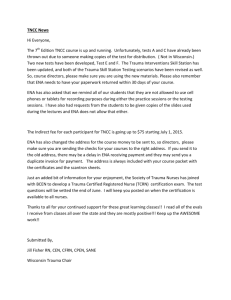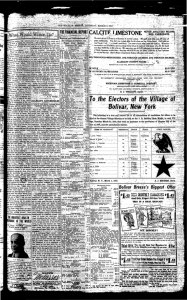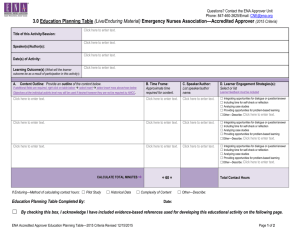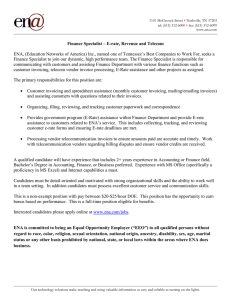ENA Guidelines - Energy Networks Association
advertisement
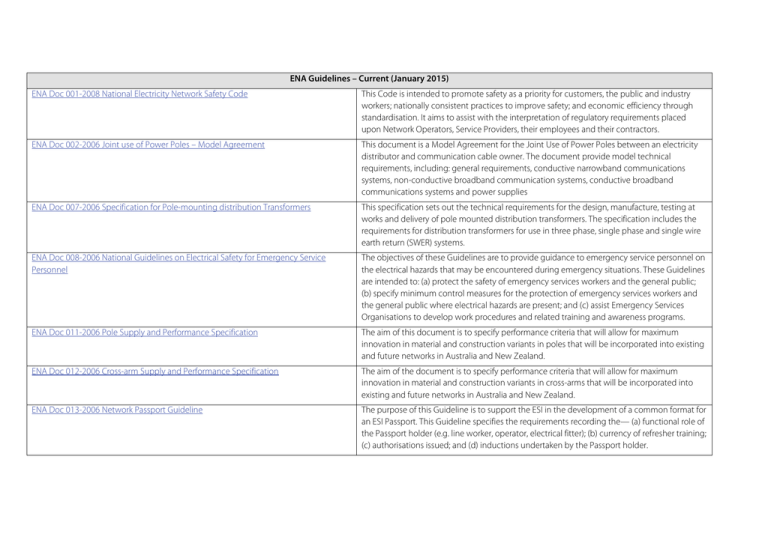
ENA Guidelines – Current (January 2015) ENA Doc 001-2008 National Electricity Network Safety Code This Code is intended to promote safety as a priority for customers, the public and industry workers; nationally consistent practices to improve safety; and economic efficiency through standardisation. It aims to assist with the interpretation of regulatory requirements placed upon Network Operators, Service Providers, their employees and their contractors. ENA Doc 002-2006 Joint use of Power Poles – Model Agreement This document is a Model Agreement for the Joint Use of Power Poles between an electricity distributor and communication cable owner. The document provide model technical requirements, including: general requirements, conductive narrowband communications systems, non-conductive broadband communication systems, conductive broadband communications systems and power supplies ENA Doc 007-2006 Specification for Pole-mounting distribution Transformers This specification sets out the technical requirements for the design, manufacture, testing at works and delivery of pole mounted distribution transformers. The specification includes the requirements for distribution transformers for use in three phase, single phase and single wire earth return (SWER) systems. ENA Doc 008-2006 National Guidelines on Electrical Safety for Emergency Service Personnel The objectives of these Guidelines are to provide guidance to emergency service personnel on the electrical hazards that may be encountered during emergency situations. These Guidelines are intended to: (a) protect the safety of emergency services workers and the general public; (b) specify minimum control measures for the protection of emergency services workers and the general public where electrical hazards are present; and (c) assist Emergency Services Organisations to develop work procedures and related training and awareness programs. ENA Doc 011-2006 Pole Supply and Performance Specification The aim of this document is to specify performance criteria that will allow for maximum innovation in material and construction variants in poles that will be incorporated into existing and future networks in Australia and New Zealand. ENA Doc 012-2006 Cross-arm Supply and Performance Specification The aim of the document is to specify performance criteria that will allow for maximum innovation in material and construction variants in cross-arms that will be incorporated into existing and future networks in Australia and New Zealand. ENA Doc 013-2006 Network Passport Guideline The purpose of this Guideline is to support the ESI in the development of a common format for an ESI Passport. This Guideline specifies the requirements recording the— (a) functional role of the Passport holder (e.g. line worker, operator, electrical fitter); (b) currency of refresher training; (c) authorisations issued; and (d) inductions undertaken by the Passport holder. ENA Doc 014-2006 National Low Voltage Electricity Network Electrical Protection Guideline This Guideline is intended to: (a) promote safety for customers, the public and industry workers; (b) promote nationally consistent practices; (c) promote economic efficiency through standardisation; and (d) simplify the interpretation of regulatory requirements placed upon Network Operators, Service providers, their employees and their contractors. This Guideline also identifies situations where practices or technology may not represent a safe situation, and identifies measures to address these situations. It is incumbent on Network Operators to periodically review their practices and available technologies for further mitigation in these areas. ENA Doc 015-2006 National Guidelines for Prevention of Unauthorised Access to Electricity Infrastructure These Guidelines have been produced to assist in the development and application of uniform requirements for prevention of unauthorised access to electricity Infrastructure. The principles and responsibilities within this document, where appropriate, should be supplemented by approved procedures. ENA Doc 016-2006 Guideline for the Management of Risks when Working Alone This guideline provides information and guidelines together with control measures for the management of the safety and wellbeing of employees required to work alone within the energy supply industry in Australia. ENA Doc 017-2008 ENA Industry Guideline for the Inspection, Assessment and Maintenance of Overhead Power Lines These guidelines cover the general principles associated with the inspection, assessment and maintenance of overhead power lines (as defined), including distribution, sub-transmission and transmission lines. ENA Doc 018-2008 ENA Interim Guideline for the Fire Protection of Electricity Substations The overall scope of the Guideline is to be outlined including relevance to new and existing substations. Some of the objectives are; · compliance with all relevant legislation · meeting functional & performance objectives · compliance with the Building Code of Australia (BCA) The relevance of the BCA and likely method of design is to be established in the final revision. ENA Doc 019-2014 ENA Land Management Guidelines The scope of these guidelines cover the most significant land management issues associated with the design, construction, operation, and maintenance of electricity and gas transmission and distribution systems. The Guideline identifies nationally significant environmental and cultural heritage (both Indigenous and Historical/European, also known as Aboriginal and NonAboriginal) issues associated with whole of life asset management and provides environmental and cultural heritage controls, references and performance indicators for ENA members to consider. Supersedes: - ENA Doc 019-2008 Land Management Guidelines ENA Doc 020-2007 National Gas Supply Industry Passport 'Guidelines and Administrative Principles' The objective of these National Gas Passport guidelines and administrative principles are to: a) support the management of safety in the Gas Supply Industry b) promote the safety of workers engaged to work on a gas network c) encourage and recognise nationally consistent practices: i. to promote ongoing development of the GSI training and skills structure, in line with industry needs; and ii. encourage a drive towards commonalities in training standards for qualifications, competencies, refresher training and authorisations including that which may not be covered by national training packages; iii. provide a consistent method for maintenance of a worker’s records; d) provide a mechanism to readily identify the skills of workers; e) provide a mechanism for determining currency of refresher training during field audits; f) provide a mechanism to record the currency of competence for a person to work on gas networks; g) encourage individuals to be responsible for ensuring the currency and validity of their qualifications, competencies, refresher training and authorisations; h) provide transportability of individuals' qualifications, competencies, refresher training and authorisations between Network Operators and their Contractors across jurisdictions ENA Doc 021-2008 ENA Industry Guideline on Measuring OHS Performance This guideline provides a framework for organisations within the Energy Supply Industry to develop measures for monitoring effective OHS performance. ENA Doc 022-2008 ENA Industry Guideline for SF6 Management This Guideline provides a range of non-prescriptive measures for organisations within the Energy Supply Industry to develop processes for the effective management of SF6 gas across the design, planning, commissioning, maintenance, decommissioning, recycling and disposal of SF6 filled equipment. ENA Doc 023-2009 ENA Guidelines for Safe Vegetation Management Works Near Overhead Lines The purpose of these Guidelines is to establish the principles applicable to safe vegetation management work near live overhead lines for various classes of persons. These Guidelines are intended to: (a) ensure the safety of vegetation management workers and the general public; (b) specify the minimum standards required for mobile plant, tools and equipment used in vegetation management work; and (c) provide the basic technical material necessary for Network Operators and Service Providers to develop work procedures, related training and awareness programs. ENA Doc 024-2009 National Guideline for Management of Tools and Equipment Used in the Electricity Supply Industry This Guideline provides guidance for electricity Network Operators and Service Providers to develop outcome based management procedures for the selection, inspection, testing and maintenance of tools and equipment utilised by workers within the Electricity Supply Industry. This Guideline applies to tools and equipment used when carrying out work on or near electrical networks, but excludes HV live work as defined by the relevant standards. This Guideline should be read in conjunction with other appropriate documentation for safe working practices related to the specific type of tools and equipment used in electrical work concerned. This Guideline intends to provide clarification on the inspection and testing requirements of insulating gloves as referenced in ENA NENS 09 National Guidelines For The Selection, Use and Maintenance Of Personal Protective Equipment For Electrical Hazards. ENA DOC 025-2010 EG-0 Power System Earthing Guide - Part 1: Management Principles, Version 1 This Guide addresses the high level aspects of policy associated with power system earthing. It provides a framework for managing earthing related risk associated with electrical power systems to meet societally acceptable levels. This framework provides principles for the design, installation, testing and maintenance of the earthing systems associated with power system assets on a.c. systems with nominal voltages up to EHV. A central part of this framework is a probabilistic derivation of allowable voltage criteria and exposure under fault conditions. It is intended for use by electrical utilities and HV asset owners, operators and customers, specifically regarding: » major substations » distribution networks » transmission lines » power stations, and » large industrial systems. It does not apply to the design or installation of any of the following which may be covered by other standards or codes: » » » » » » » customer premises LV earthing (refer AS3000) earthing systems associated with d.c. systems earthing systems associated with electric railway traction systems earthing systems on ships and off-shore installations test sites mining equipment and installations electrostatic equipment (for example, electrostatic precipitators). ENA Doc 026-2010 ENA Guideline for the Management of Burning and Fire-damaged CCA Impregnated Poles and Cross arms This document is applicable to: ENA Doc 027-2010 ENA Technical Report - Guide for the Selection and Management of Poles to Reduce Damage and Loss when They are Exposed to Bushfires Recent research (Gardner and White, 2009) and observations (Gardner and Price, 2009) following the February 2009 bushfires in Victoria, demonstrate that the performance of poles exposed to severe bushfire attack will vary. The purpose of this document is to provide guidance on the selection and management of poles for use in bushfire-prone areas. ENA Doc 028-2010 ENA Technical Report for the Mitigation of Pole Top Fires The intent of this document is to provide network service providers with a range of options for mitigating pole top fires that may assist in formulating individual business proactive and reactive strategies. It should be noted that network service providers may not necessarily undertake any or all of the mitigation options outlined in this document due to the diversity in network design across Australia. This document is based on current practices employed across all elements of the Australian electricity supply industry at the time of publication. It is not meant to exclude new technologies or practices that may evolve in the future. ENA Doc 029-2011 Technical Report for Electricity Network Development (Subtransmission and Distribution) This Technical Report is intended to provide an introduction and to highlight key issues that need to be assessed by Network Service Providers (NSPs) in the network development planning process. Its focus is on distribution and sub-transmission networks. It does not specifically cover transmission networks although some of the topics are applicable to those networks. To assist the reader, greater insights are provided through references to other documents including codes, Australian Standards and International Standards. » Copper Chrome Arsenate (CCA) impregnated poles and cross arms—hereafter collectively referred to as CCA impregnated poles » CCA impregnated poles that are burning, or have suffered damage, as a result of exposure to bushfires or pole top fires, and » CCA impregnated poles in service. Handling fire-damaged CCA impregnated poles, or attempting to extinguish CCA impregnated poles that are burning, presents hazards to the worker not found when working with other timber products. Chemicals normally locked in the timber cells during treatment are released, creating a hazard in the working environment. The following documentation provides advice to those workers who, in the course of their duties, may be exposed to either burning or firedamaged CCA impregnated poles. ENA Doc 030-2011 ENA Guideline for the Preparation of Documentation for Connection of Embedded Generation within Distribution Networks The intention of this document is to provide a national reference framework for the preparation of documentation for connection of embedded generation within distribution networks. With the increasing connections to the DNSP’s involving embedded generation and customers operating across multiple jurisdictions there is a need for more consistency across the individual DNSP’s processes, policies and documentation. The purpose of this document is to provide general information to assist the DNSP in developing and or reviewing documentation for customers in relation to embedded generation. Each DNSP operates under its respective jurisdiction having requirements at Local, State and other levels which will determine specific documentation content. This document discusses general connection issues including, process, fees and conditions, asset ownership, payments, technical standards, metering, protection, SCADA, communications, quality of supply, installation and maintenance. ENA Doc 031-2011 ENA National Guideline for Mobile Plant Earthing This document is intended to provide: • Guidance on earthing for mobile plant to help mitigate the electrical risks that can arise when mobile plant is being used on or near live overhead electrical apparatus including transmission, sub transmission and distribution lines and substations. • Assistance in the decision making process to earth or not earth. • Guidance on the limitation of various earthing systems. • Guidance to applying earths and precautions. ENA Doc 032-2012 Guideline for the Selection, Installation, Identification, Performance, Inspection and Maintenance of Pole Reinforcement Methods The scope of this guideline covers the selection, installation, identification, performance, inspection and maintenance of groundline pole reinforcement systems. These guidelines are not intended to cover: » Temporary application of pole reinforcement » Composite poles including rebutted poles These guidelines are intended for use by: ENA EG1-2006 Substation Earthing Guide » Asset owners, having applied criteria for the suitability for reinforcement » Manufacturers and Suppliers of pole reinforcement systems » Installers & Maintainers of pole reinforcement systems. The purpose of this guide is to provide guidelines for the design, installation, testing and maintenance of earthing systems associated with electrical substations. Earthing systems that are covered in this guide include those associated with: generating plants, industrial installations, transmission and distribution stations. Internal wiring and equipment/appliance earthing details are not addressed in this document. ENA NENS 03-2006 National Guidelines for Safe Access to Electrical and Mechanical Apparatus These Guidelines provide principles and responsibilities for control authorities and service providers for access to apparatus associated with the generation, transmission and distribution of electricity. These Guidelines also detail the minimum general requirements for work to be carried out under access authorities. These Guidelines are not intended to cover specific requirements for other work such as welding and cutting, working at heights, mobile plant, confined spaces, excavation work or work on extra low voltage exposed conductors. The application of approved live high voltage working techniques is not covered by these Guidelines. ENA NENS 04-2006 National Guidelines for Safe Approach Distances to Electrical and Mechanical Apparatus These Guidelines are intended to— (a) Support the Electricity Supply Industry in ensuring the safety of electrical and other workers and the general public by the development of appropriate Safe Approach Distances to electrical apparatus for various classes of persons, and mobile plant and equipment. (b) Provide the basic technical material necessary for Network Operators to develop work practice, and related training and awareness programs. (c) Provide recommendations for appropriate Safe Approach Distances for members of the general public. (d) Provide the Electricity Supply Industry with a sound basis for controlling activities, where possible, of the general public near network assets. ENA NENS 05-2006 National Fall Protection Guidelines for the Electricity Industry The objective of these guidelines is to establish the principles applicable to fall protection when working at heights within the Electricity Industry. Their adoption and application will enable the development and maintenance of safe systems of access to, egress from, transfer between work positions upon and working aloft on poles, lattice structures, substation equipment and related structures, consistent with prevailing legislative requirements. ENA NENS 07-2006 National guidelines for Manual Reclosing of High Voltage Electrical Apparatus Following a Fault Operation (Manual Reclose Guidelines) The objective of this document is to provide guidelines applicable to manually reenergising high voltage electrical apparatus following a fault operation by bringing together best practice ideas sourced through the Electricity Supply Industry. These guidelines will encourage a national convergence in approach towards best practice in regard to the management of risk associated with the re-energising of electrical apparatus following a fault operation. This convergence in approach will also facilitate community and emergency services awareness regarding the potential dangers associated with electrical apparatus during fault situations. ENA NENS 08-2006 National Guidelines for Aerial Surveillance of Overhead Electricity Networks The objective of these Guidelines is to support the Electricity Supply Industry in the development of appropriate safe working processes for aerial surveillance of Overhead Electricity Networks. The principles within these Guidelines may be enhanced or supplemented provided this does not result in reduced safety standards. These Guidelines are intended to: (a) ensure the safety of pilot, monitor(s) and the general public; (b) specify the minimum standards required for aerial surveillance of Overhead Electricity Networks; and (c) assist Network Operators to develop work procedures and related training and awareness programs. ENA NENS 09-2014 National Guideline for the Selection, Use and Maintenance of Personal Protective Equipment for Electrical Arc Hazards This Guideline covers the clothing and apparel designs, the minimum performance levels of the materials used and the methods of test to determine the performance levels. Supersedes: NENS 09 - 2006 National guidelines for the selection, use and maintenance of personal protective equipment for electrical hazards This Guideline does not consider protection from electric shock or test for the electrical conductivity of the associated PPE. This Guideline does not consider protection against other hazards, e.g. chemical, biological, noise and radiation hazards. ENA NENS 10-2005 National Guidelines for Contractor Occupational Health and Safety Management The objectives of these Guidelines are to provide a systematic approach to managing contractor occupational health and safety (OHS) in the Electricity Supply Industry. These Guidelines are intended to: (a) promote safety as a priority in managing contracts; (b) promote nationally consistent practices for the OHS management of contract works; and (c) promote economic efficiency through standardisation of contractor OHS management. ENA Doc 033-2014 Guideline for Power Quality: Harmonics. Recommendations for the The purpose of this guideline is to provide a coherent and practical guide to the application of the Joint Australian/New Zealand Technical Report, TR IEC 61000.3.6:2012, for limiting harmonic voltages in medium voltage (MV) and high voltage (HV) distribution networks, and to present a simplified approach that a particular DNSP may elect to adopt under certain circumstances. It should be understood that this guideline is not binding and the DNSP’s own harmonic management policies shall prevail. The Joint Australian/New Zealand Technical Report is an identical adoption of the IEC publication IEC/TR 61000-3-6, Ed 2.0 (2008). The guideline is also intended to serve as a supporting document to the National Electricity Rules and other jurisdictional technical electricity rules. application of the Joint Australian/New Zealand Technical Report TR IEC 61000.3.6:2012 ENA Doc 034-2014 Guideline for Power Quality: Flicker - Recommendations for the application of the Joint Australian/New Zealand Technical Report TR IEC 61000.3.7:2012 The purpose of this guideline is to provide a coherent and practical guide to the application of the joint Australian/New Zealand Technical Report, TR IEC 61000.3.7:2012 for limiting voltage fluctuations in medium voltage (MV) and high voltage (HV) distribution networks, and to present a simplified approach that a particular DNSP may elect to adopt under certain circumstances. It should be understood that this guideline is not binding and the DNSPs own voltage fluctuations management policies shall prevail. The Joint Australian/New Zealand Technical Report is an identical adoption of the IEC publication IEC/TR 61000-3-7, Ed 2.0 (2008). The guideline is intended to serve as a supporting document to the National Electricity Rules and to Rules of other DSNPs that do not come under the jurisdiction of the Australian Energy Regulator (AER).
